
25 minute read
SHAFT SINKING
Integral infrastructure

Advertisement
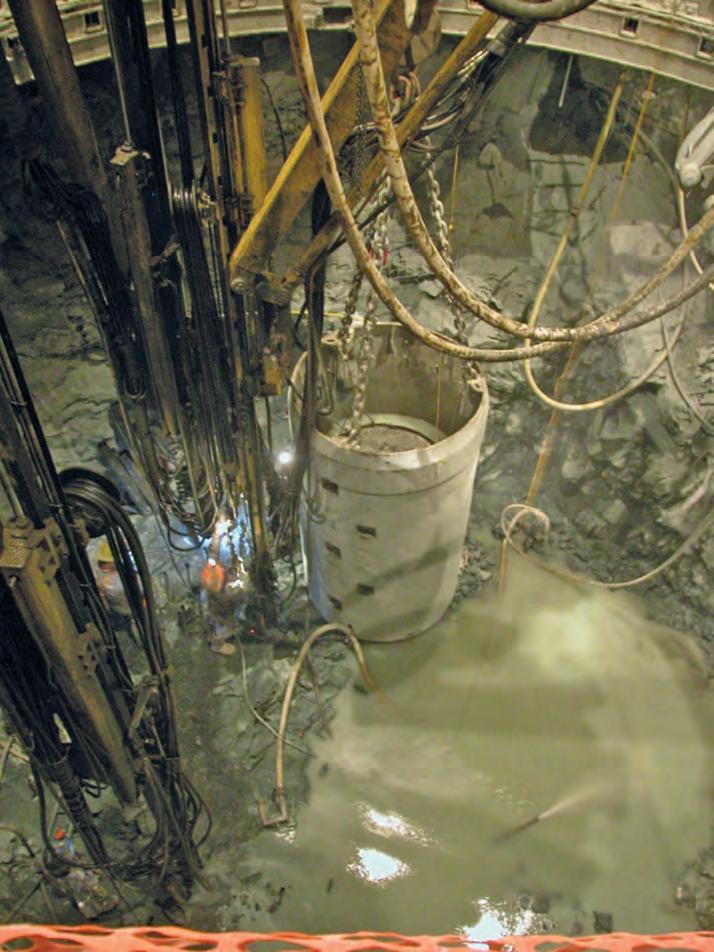
With the post-COVID-19 commodity price revival up and running, greenfield and brownfield developments are back on the agenda. Dan Gleeson looks at some of the shaft sinking projects and contractors set to unlock this new growth
COVID-19 has affected every part of the mining process; from logistics to mineral processing, to drilling and blasting and exploration, to human resources and catering.
The shaft sinking sector has not been spared – it is hard to abide by social distance requirements at the bottom of a mine shaft without it affecting productivity – yet, it has fared better than some mining developments, with the majority of shaft sinking projects continuing throughout the pandemic.
Eric Kohtakangas, Executive VP of Growth & Acquisitions for Cementation Canada, explained why this might be: “Given that shafts often fulfil a vital ventilation function beyond access or material handling, it could be assumed that shafts would remain high in clients’ priority of their portfolio of planned works, especially for mine expansions and approved greenfield sites,” he said.
This has certainly been the case at some highprofile projects such as the Turquoise Ridge Third Shaft in Nevada, USA, the Macassa #4 Shaft project in Ontario, Canada and the Nezhinsky potash project in Belarus (more later).
Surprisingly, all three of these projects have remained within or ahead of schedule despite the pandemic headwinds.
The third shaft at Turquoise Ridge, a mine owned 61.5% by Barrick and 38.5% by Newmont within the Nevada Gold Mines joint venture, was recently sunk to its final depth of 989 m below the collar in June.
Barrick said in its June quarter results: “Construction of the Third Shaft at Turquoise Ridge, which has a hoisting capacity of 5,500 t/d, continues to advance according to schedule and within budget. We continue to expect commissioning in late 2022.”
Together with increased hoisting capacity, the development of the Third Shaft, steered by Thyssen Mining, is expected to provide additional ventilation for underground mining operations as well as shorter material haulage distances.
The focus of the project is now shifting from sinking activities to equipping, with fabrication of the shaft and loading pocket steel underway, as well as other early procurement items necessary to complete the construction of the project.
At Macassa, the #4 Shaft project remained over a month ahead of schedule at the end of the June quarter, and was on track for completion in late 2022 .
This shaft, engineered by Cementation Canada but sunk in-house by Kirkland Lake Gold crews, could lead to production at the highgrade gold mine growing to over 400,000 oz/y at significantly improved unit costs, according to Kirkland Lake. In addition, working conditions will be improved at the mine, with total ventilation capacity expected to more than double. Future exploration activities could also be positively impacted .
Both examples prove Kohtakangas’ point, while highlighting just how skilled these shaft sinking specialists are.
Shaft sinking operations at 9600L elevation –Kidd Mine D Shaft now part of Glencore Kidd Operations in Timmins, Ontario
A double-edged sword
Jochen Greinacher, Managing Director of Redpath Deilmann, is aware of such skill, referring to the team that sunk the shafts at the Nezhinsky mine, in Lyuban, Belarus, as “exceptional”.
This team, aided by the second generation of Herrenknecht’s Shaft Boring Roadheader (SBR), broke a company record dating back to 1938, which, itself, was achieved at a time when safety was far from the main consideration on shaft sinking projects.
The Nezhinsky team, in contrast, completed the whole sink and equipping of both shafts ahead of schedule with a Herrenknecht SBR while registering just one reportable accident (finger injury).
The use of the SBR, which allowed simultaneous excavating and lining without exposure to the shaft bottom in many sections of the Nezhinsky sinking project, undoubtedly played a role, but the team controlling that machine had to battle weak rock, water ingress
The Redpath Deilmann Nezhinsky team completed the whole sinking and equipping of both shafts ahead of schedule with a Herrenknecht SBR while registering just one reportable accident (finger injury)

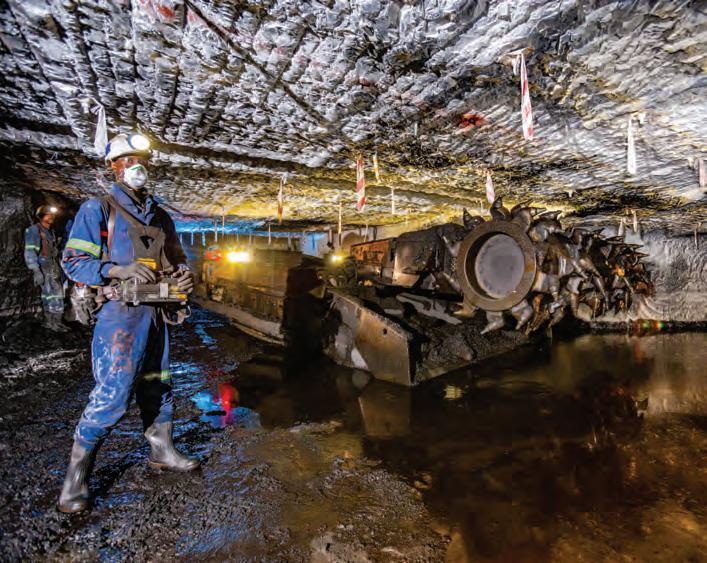

and geological problems below the initial freeze section – along with ongoing COVID-19 restrictions – to complete the project ahead of schedule.
The fact it did so while breaking a company record is astonishing.
Made up of a combination of German, Belarussians, Russians and other nationalities, the team is now putting the final touches to the 8-m diameter shafts (one 750 m depth and one 697 m depth) at Nezhinsky. Shaft #2, the service shaft, is now fully equipped, and will be used to transport muck from underground development work – expected to take upwards of a year – at the potash project.
“We’re more or less finished with the ‘shaft sinking’ side of things in Belarus,” Greinacher said. “This means we have a really good team available ready to be deployed elsewhere.
“Yet, this is a double-edged sword. We need good people to run a project, but we also need a project to employ those people.”
In terms of a potential project involving an SBR, only one remains out there in the territories that Redpath Deilmann is focused on (Europe and Russian-speaking countries), according to Greinacher.
The potential work in Poland to sink shafts for a coal project – mentioned in this same feature last year – has been hit by incoming EU regulations around thermal coal developments, while most other sinking projects up for tender are from metal mines where the SBR, which has a cutting mechanism suitable for soft-tomedium-hardness-rock, would not be considered.
This isn’t to say the SBR’s days are numbered. Far from it.
Greinacher, in reviewing the team’s and SBR’s performance in Belarus, said: “On average, we advanced a little more than 3 m/d under some very difficult conditions. I think the peak performance was 7.4 m/d, or 150 m/mth, the latter of which was averaging 5 m/d. By that point, we were in the bottom section of the shaft where conditions were optimal.
“The team was perfectly aligned, and the machine performed very well – we made some modifications to it at the beginning, as is typically done on such projects – and the rock conditions were very good.
“We achieved records later, when the SBR was in rock salt, and there is nothing better than rock salt for such sinking work.
“Yet, there is still room for improvement. If we were to undertake a project under similar conditions, we could probably exceed the performance we achieved in Belarus by about 20%.”
Such a benchmark means the SBR is likely to crop up in future projects outside of Woodsmith in the UK (see Watching Woodsmith boxout).
When it comes to rock cutting, the Nezhinsky team might soon
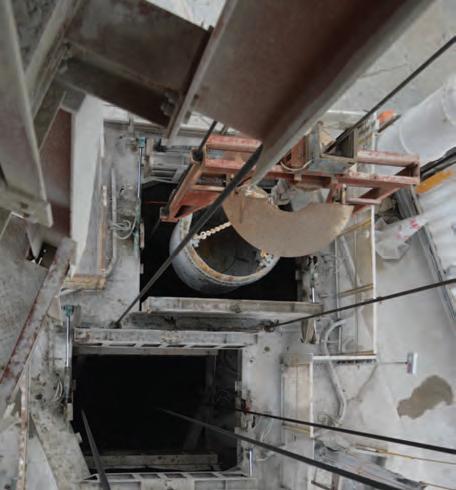
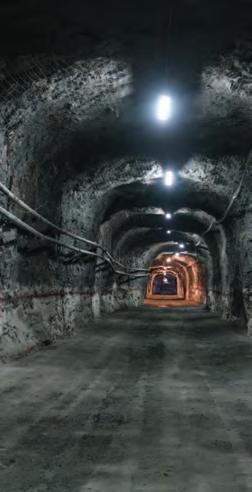

be able to realise with another mechanised technology that could sink shafts in much harder rock.
The Shaft Boring Cutterhead (SBC) being developed by Herrenknecht with support from Redpath Deilmann is that technology, according to Greinacher.
The SBC is expected to be able to cut rock with a uniaxial compressive strength (UCS) of up to 260 MPa rock down to 1,500 m depths with shaft diameters ranging from 8-9 m.
Greinacher said the experience both companies have gained using the SBRs has been leveraged for the design and engineering of the SBC.
Built with a cutterhead like a tunnel boring machine (TBM), it can deliver an advance rate of 6 m/d under the right conditions, according to Herrenknecht. It is also equipped with a pneumatic mucking system able to handle more abrasive rock like that of the latest generation SBR.
COVID-19 has pushed some of the SBC testing timelines back, but work to optimise the shape of the cutterhead – one of the core components of the machine considering it could be faced with cutting rock that has a UCS of up to 260 MPa – is currently taking place at Herrenknecht’s facility in Schwanau, Germany.
Both Herrenknecht and Greinacher are hopeful of the core cutter section being built and tested within the first half of 2022. During the latter stages of testing, interested parties are likely to be invited to Schwanau to witness this system in action.
Speaking of interested parties, Greinacher said he has already had conversations with miners in Kazakhstan and Russia avidly watching developments with the SBC.
While large-diameter raiseboring technology (explored in more detail later) is being factored into studies looking at mechanised sinking options in North America, the SBC technology is an easier sell in Russian-speaking countries, according to Greinacher.
“On one project looking at sinking three shafts, we proposed sinking two shafts with the SBC and raiseboring or pilot and slashing the third one,” he said. “They rejected the idea for the third shaft and were more open to the use of the SBC as, for them, it is proven TBM technology that has simply been turned on its head.
“At the same time, in the geologies we are looking at there are sometimes softer sections of rock to cut. If you are to raisebore big shafts of over 1,000 m successfully, you require stable hard rock over the entire length.”
Consistent conditions are hard to come by in any sinking project and that is why Redpath Deilmann – and the wider Redpath group – is also pursuing a project to automate both the drill and blast part of conventional shaft sinking, as well as the mucking element.
Greinacher provided details of this concept in last year’s shaft sinking feature and was ready to tell more when IM spoke to him last month.
“The design is more or less complete and we’re on the procurement phase now,” he said. “We will have the prototype assembled shortly and then we will start the testing at our factory.”
The idea is to have all functions carried out independent of the main galloway, removing personnel from the shaft bottom, while increasing sinking performance. Such an innovation is likely to leverage the Redpath Shaft Control System: a patented communication system to collect information from virtually any electronic device on the market in real time to maintain operations within anticipated parameters.
The initial design includes a backhoe-type mucking system attached to the galloway that allows the mucker to advance towards the muck pile while the operator sits in the galloway.
“If you have a 5 m muckpile on the bench, you can lower the excavator to capture more muck in the bucket,” Greinacher explained, adding that the patent for this system was in preparation, hence the reason he could not share more details.
From here, the aim is to assemble the machine and test its functionality on a manual basis from the galloway in a process representing step one of the project.
“It is set up to be semi-automated,” Greinacher said. “But the vision and the systems are designed that all functions can be carried out remotely, either from surface or from somewhere else. Eventually this work could be carried out autonomously.”
This vision – representing step two or three of the project – will be facilitated by 3D cameras and sensors that have been tested and developed within the wider Redpath Group.
Advanced communications
While Redpath Deilmann has been advancing this system in Dortmund, Germany, Redpath’s office in North Bay, Canada, has been collaborating and reviewing the work-up of design criteria and functional approaches for the unit, according to Kevin Melong, Vice President – Shafts and Technical Services.
For Melong, the concept represents “the next significant step-change in shaft sinking”.
Being able to muck the shaft bottom independently of the main galloway with no workers present on the bottom comes with obvious safety benefits, but also offers the ability to safely perform concurrent shaft and lining work with automated bottom mucking to provide a potential productivity boost.
More broadly, Melong and his Redpath colleagues have been exploring the knock-on benefits that come with applying the Redpath Shaft Control System, which is now embedded within all the group’s shaft sinking work.
This uses a combination of hardwired and wireless technologies and protocols, such as programmable logic controllers and sensing equipment, to safeguard against unwanted equipment interactions and optimise routine tasks. The ability to record and trend this information promotes opportunities for continuous improvement and optimisation to both operational procedures and equipment use, Redpath said.
“These systems allow us to reimagine the shaft sinking approach as data transfer leads to a myriad of control and automation possibilities,” Melong told IM.
Wireless communication has also allowed the company to receive visual information from mounted cameras on both the crossheads travelling in the shaft, as well as the various decks of the galloway, to more closely monitor the interaction between hoist conveyance and the galloway.
“The statuses of the crosshead rope button release and latch arm positions is also transmitted wirelessly to the safety control
Redpath Raiseboring completed a record-breaking hole at Kirkland Lake Gold’s Macassa Mine in Ontario, Canada, with a manufactured-in-Ontario Redbore 90. At a length of 1,010 m, the raise became the longest raisebore hole ever accomplished in the Northern Hemisphere and all the Americas
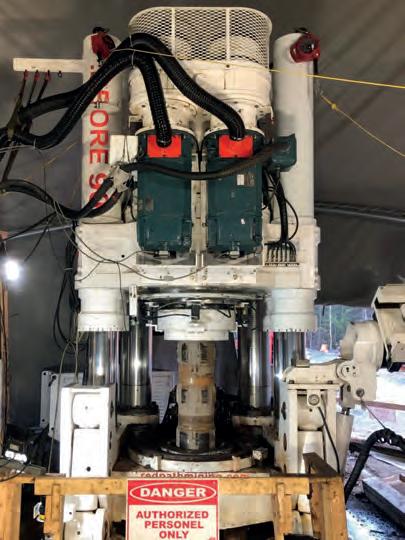
circuit, providing a solution to the age-old problem of incomplete crosshead detachment and release problems,” Redpath said.
Seeking to further secure the galloway, the company has recently introduced a galloway stage rope monitoring system that detects the slightest changes in loading, inclusive of rope stretch and position within the shaft, Melong said. This ensures the rope factor of safety is not compromised and potential damage to the stage and shaft furnishings is eliminated.
The level of instrumentation and controls used to reduce risks when moving the galloway have also stepped up, with: n The use of variable frequency drives to control speed and position on winch motors; n Load cells to monitor rope tension; n Emergency stop buttons on every deck; n Inclination sensors to measure plumbness; n Accelerometers to measure vibration and detect impact; n Optical sensors to measure the distance to the shaft walls; n Strain gauges on structural members to measure stress and strain; and n Real-time video footage from dozens of HD cameras.
Jeremy Berg, Manager, Engineering & Technical Services at Redpath Canada, said: “Recently, all of these innovations have been combined to create a safety system designed to limit the impact energy seen by the galloway structure. This can provide a feasible justification for the reduction of safety factors in the structural design of galloways and work stages in special circumstances.
“These same systems have also been used by Redpath to safely lower massive structures in the shaft without the need for direct personnel supervision, increasing safety and productivity in these nonroutine shaft activities.”
In addition to wireless communications, the company’s patented Integrated Leaky Feeder Mesh system has been installed in two shaft projects in Ontario to improve data transmission. Berg said the company had learned some important lessons regarding installation techniques and environmental considerations to improve future designs.
“We are currently speaking with another client about using this system in the permanent shaft configuration after we finish the sinking contract,” he added.
One can add to this list of Redpath innovations the development of: n The “shaft bells location identifier”, which communicates to the hoist operator where the shaft signals (or bells) have been rung from, allowing for interlocks which permit hoist movement only when bells are received
The start of reaming using a Strata 950 raisebore machine for the first leg of a 5.5m diameter, 470 m long shaft at the Northgate Production Shaft, now owned by Alamos Gold Inc in Matachewan, Ontario

FROM IDEA TO OPERATION
Our EPCM solutions can help get your development projects off—and into—the ground.
stantec.com/mining-epcm
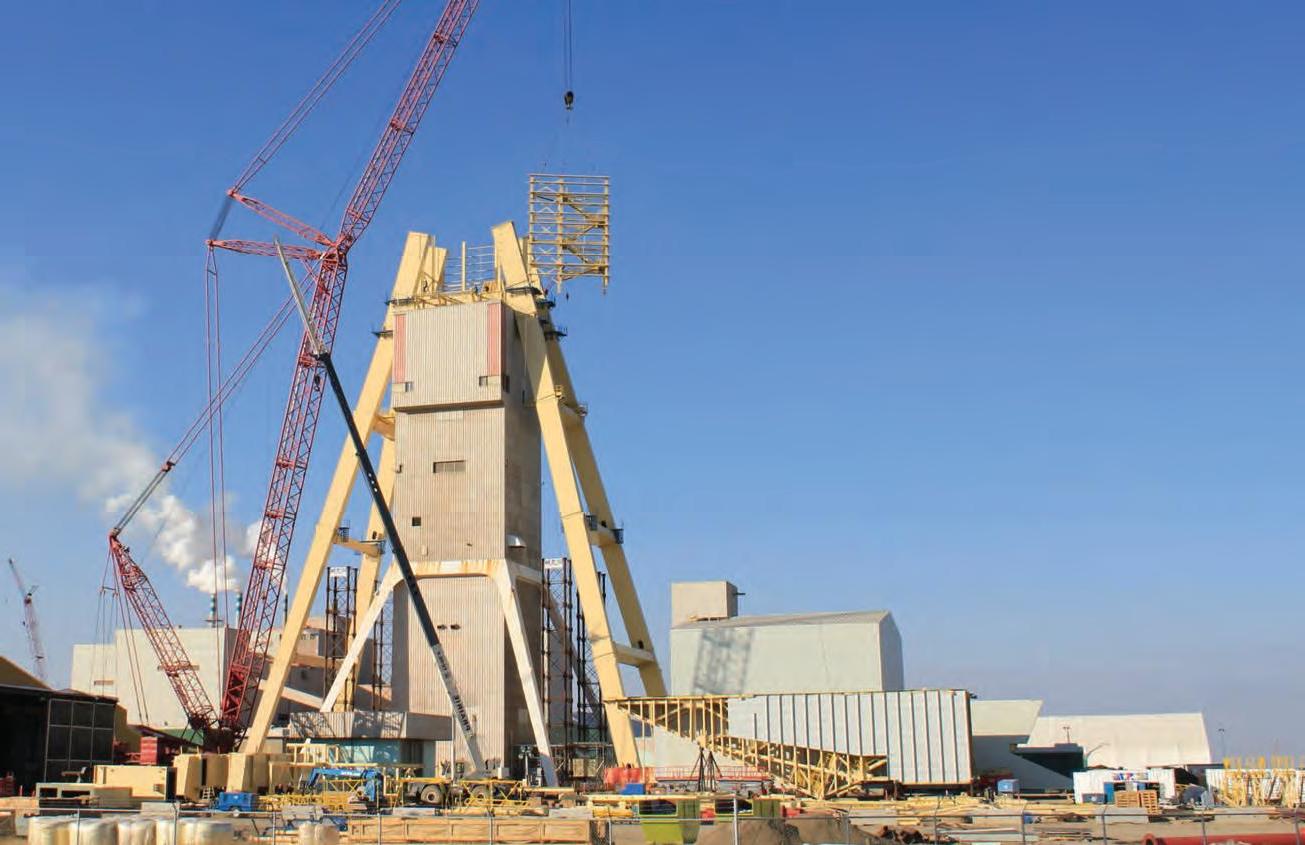
Watching Woodsmith

The next challenge for Herrenknecht’s SBR technology is fast approaching at the Woodsmith project, a polyhalite development owned by Anglo American situated on the North Yorkshire coast of England.
The use of SBRs was slated for this project by Sirius Minerals (the former owner) all the way back in 2018, with orders for two units able to sink production and service shafts with 6.75-m diameters to depths of 1,594 m and 1,565, respectively. The orders came to Herrenknecht less than a year after Redpath Deilmann secured two SBR machines for its work sinking the 8-m diameter shafts in Belarus.
DMC Mining was initially attached to the sinking of these two shafts, plus two circa-390-m-deep smaller shafts associated with the materials transport system, but Anglo American cancelled this contract around a year ago. A spokesperson, at the time, said the new structure that came with DMC’s exit provided the company with simpler internal processes, allowing it to “better manage the important transition between the sinking phase and ramp-up to steady state operations”.
During the company’s recent investor call, Anglo American Chief Executive, Mark Cutifani, confirmed the small intermediate shaft for tunnel ventilation and access, being developed by blind drilling, had reached its full depth of 383 m at the end of June and was being lined before connecting it to the material transport tunnel to run from Teesside to the mine in Whitby.
Work on the service shaft with the SBR had begun, with the “first cut” occurring in late July, he added.
Anglo is in the process of carrying out a review of the sinking project to support compliance with its internal standards. This includes engineering, cost and schedule, with the SBR shaft sinking schedule another element under scrutiny.
An Anglo American spokesperson told IM last month: “We are now in readiness to commence shaft sinking operations during the course of August, and intend to assess the performance of the SBR over the coming months so we can better predict its forward progress to inform the overall schedule.”
The spokesperson added: “Regarding the SBRs themselves, several improvements and upgrades have been made to it from the first and second models used at Jansen in Canada and Nezhinsky in Berlarus.”
This includes the addition of two retractable robotic probes to test and grout the ground ahead to facilitate safer excavation, plus the installation of an additional control cabin on surface to reduce downtime by allowing the machine to continue to be operated remotely during shift changeovers.
Two Herrenknecht Shaft Boring Roadheaders will be used to sink production and service shafts with 6.75-m diameters to depths of 1,594 m and 1,565, respectively, at the Woodsmith potash project
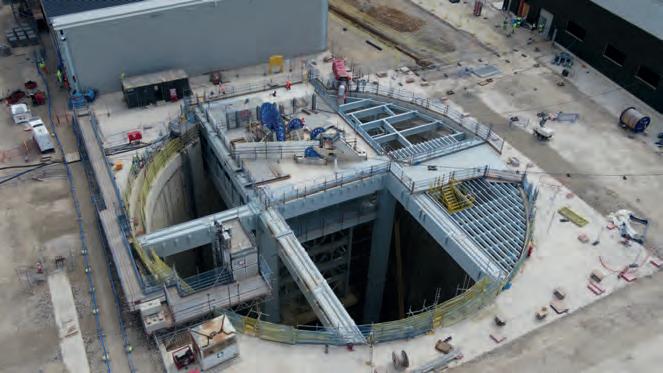
form a station within visual range of the conveyance; n A full shaft stop control button on every deck of movable work platforms for complex shaft remediation where multiple hoist and rehabilitation platforms may be operating in the same shaft; n Laser scanners at the collar and sub-collar doors to ensure that collar doors are clear of obstructions and objects that could fall into the shaft prior to opening/closing; n A “unique” under-slung hydraulic excavating shaft mucker to provide the flexibility to cut, chip, or drill and blast the frozen ground; and n A battery-powered mechanised raise climber, as well as a remote camera inspection unit for similar climber systems, for face inspection prior to re-entry.
Melong said the Redpath group is tendering for several shafts – both sinking and rehabilitation – in Canada, while there are active tenders in Europe and on-going discussions for shaft work in North America as well as Central America.
In the Americas markets, the mechanised sinking technology most frequently discussed is large-diameter raiseboring.
Redpath has had serial success with this technology, and Melong says the option of raiseboring a shaft is more readily being considered in some markets, even if the tradeoffs associated with using this technique are not.
“Boring shafts for ventilation, versus production or conveyance operation, are two different challenges,” Melong explained.
“The investigation into a raisebored shaft versus other approaches such as blind sink can be significant, with aspects such as boreability, stand time, hydrogeology, geo-mechanical and verticality constraints for its end use needing to be clearly understood.”
Often, the volume of waste material the mine must handle among its normal requirements renders the approach unfeasible, inhibiting the mine from hitting its productivity goals as well as well as the mine development targets, according to Melong.
He provided an example of the factors that need to be considered during such investigations.
“We have recently competed a deep multi-leg raisebore production shaft in Zambia (Mindola Deeps) as well as a number of deep holes in that
region,” he said. “Verticality challenged the approach to the production shaft, as the useable envelop remaining in a bored shaft if the hole isn’t perfectly vertical will reduce the useable area of the hole in most cases if hoisting is to be conducted in it.” Options exist to directional steer or drill the hole oversized to account for this misalignment, but the trade-offs must be considered to understand the impact to cost and schedule, Melong added.
“In most cases, a winding system and headworks must be installed to support the ground and install guidance systems, further bringing the option back closer to the cost and schedule of blind sinking,” he added.
With the company having completed a second record-breaking raisebore in the Americas this year – a 1,010-m-long raisebore at Macassa no less – IM asked Melong: is large-diameter raiseboring technology close to hitting a ‘ceiling’?
“We have completed some near world record holes recently, in terms of depth and diameter,” he said. “As the depth and size of holes are absolute functions of ground conditions, that is difficult to say, but limits on current raisebore machines seem to be near, or at their capacities.
“In this equation, depth and diameter equate directly to higher risk to machine and hole success.”
The benefits of groupthink
For a large diameter raisebore to be successful, at a basic level, one must provide positive answers to the following four questions, according to Cementation Canada’s Kohtakangas: n Is the size and length of the opening within current capabilities? Broadly speaking, you can ask: is your raise (or sections of raise) no longer than 1,000 m long? n Is the ground suitable? ie, is the rock suitable for excavation by raisebore in terms of sidewall stability and stand-up time? Are water inflows not likely to be an issue? n Do you have access to the shaft bottom?
Access is necessary to the lower horizon for installation of the reamer head as well as for the mucking of cuttings; and n Can you handle the waste generated underground? Do you have capacity to handle the additional muck volume that will be generated and the different muck size to development or production muck?
With Cementation continuing to test the limits of this mechanised technology for shaft sinking – including an upcoming bore of about 8.5-m diameter – Kohtakangas is continuing to see this option considered in studies and trade-offs when the company’s engineering studies group is engaged early on in a project.
“It can offer significant capital and schedule advantages under the appropriate conditions,” he said. “Certainly, the proven ability of longer, large-diameter raisebored shafts gives mine planners and engineers increased options to optimise brownfield operations, whether through increased ventilation or increased capacity of waste/production hoisting, or more efficient mine access as the mining centre of gravity moves away from established infrastructure.”
This was the case at the Northgate shaft at AuRico Gold’s (now Alamos Gold’s) YoungDavidson gold mine in Ontario, according to Kohtakangas.
On this project, the company separated the new raisebored shaft into legs – with a mid-shaft loading pocket – to allow the client to smooth the spending profile and realise early production, he said.
This shaft, commissioned last year, was designed to boost underground production at Young-Davidson from 6,000 t/d to 8,000 t/d as the existing mid-mine infrastructure was replaced with the new lower mine infrastructure.
Kohtakangas sees potential for using largediameter raiseboring in combination with blind sinks in projects too.
“This has always been the case when developing a new shaft-accessed mine –consideration of raises (more so bored raises now) to complete the ventilation circuit in parallel with a shaft (or decline) and to provide second egress,” he said. “Existing mines have



A globally reliable partner, providing a customized approach delivering value through all project stages.
Cementation Americas Group of Companies
Mine Development & Construction • Shaft Sinking • Raise Boring Contract Mining • Mining Material Handling Solutions Crushing & Conveying Systems • Mobile Stacking Systems Feasibility & Design Engineering • Project & Construction Management
the ability to accommodate a raisebore pilot and slash and blind sink method in combination.”
The Onaping Depth project for Glencore in Sudbury is a good example of this where the shaft project, led by Cementation Canada, is currently transitioning from a raisebore pilot and slash in the top portion of the shaft, to a blind sink method for the lower half.
Cementation Canada is continuing to work and exchange ideas such as this within the wider Murray & Roberts Group to improve industry best practice.
Here, it has been able to leverage the learnings from Africa-based Murray & Roberts Cementation, in notching up five million fatalityfree shifts earlier this year as part of a concerted corporate journey towards Zero Harm.
Underpinning much of this success in safe working practices was the increased investment in training strategies at the Murray & Roberts Training Academy at Bentley Park near Carletonville, South Africa. This facility uses the latest technologies and methods – supported by realistic mock-ups of mining environments – to ensure workers are fully prepared for all working conditions, the company said.
Mike Wells, Managing Director of Murray & Roberts Cementation, explained: “Our mining customers today regard the commitment to fatality-free operations as a given – not only for themselves but for their service providers. We are proud to be able to demonstrate our success as part of the broader progress in this field by the whole mining sector.” Over the years in which the five million fatality-free shifts have been achieved, Murray & Roberts Cementation has conducted a diverse range of projects across sub-Saharan Africa, including large shaft sinking contracts such as the Mufulira Deeps sinking project, in Zambia, which was triple raisebored down to 1,587 m depth. The learnings go both ways, with other group companies learning from Cementation Canada’s use of real-time data acquisition technology for short interval control of the sinking process. Meanwhile, a pre-sink gantry system developed in South Africa by Murray & Roberts Cementation is also gaining prominence across Australia, through RUC Cementation Mining, and elsewhere. “In general, each project is evaluated against group experience for what we consider the optimised approach for the particular scope, ground conditions and client success criteria,” Kohtakangas said. This process would have been carried out for the shaft work at Jansen, in Saskatchewan, Canada, where Cementation Canada has recently secured a contract with BHP to carry out the post-liner excavation, steel and equipping of the shafts for the first 4.35 Mt/y phase of the potash project. Kohtakangas concluded on the subject: “Shaft sinking has significantly changed over the last 20 years and is much safer today. As shaft sinkers, we continually look at new ways to improve all aspects of sinking, including safety and performance. “Each shaft sinking project is different and it requires optimising the best temporary sinking method and design with the permanent shaft design.” IM
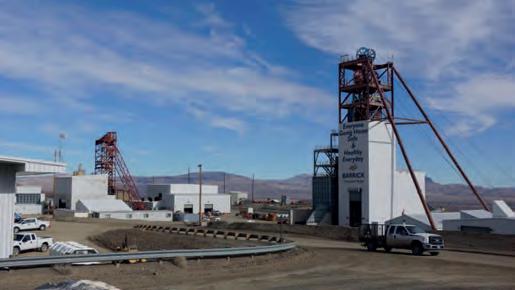
Construction of the Third Shaft at Turquoise Ridge will provide an increase in hoisting capacity to 5,500 t/d Lucara Diamond Corp’s Karowe Underground Expansion project (UGP) in Botswana has recently moved ahead with mobilisation of shaft sinking teams commencing late in June, and pre-sinking activities scheduled in the September quarter.
The Karowe UGP, which is expected to extend the operation’s mine life to 2040, is in a fullyfinanced position, with the latest schedule expected to see underground production hit full production by the end of 2026.
The 2019 feasibility study for the project envisaged life of mine production of 7.8 Mct, a payback period of 2.8 years and an after-tax NPV (5% discount) of $718 million; all from $514 million in preproduction capital.
COVID-19 delays have pushed the project off the original schedule – both in terms of timeline and cost – but the company is now making headway towards a 2026 start to underground production.
Access to the underground mine will be via two vertical shafts, the production and ventilation shafts. The shafts will be concrete lined with the production shaft acting as the main air intake and the ventilation shaft as the exhaust.
The planned depth of the production shaft is around 767 m, while the final planned depth of the ventilation shaft is 733 m. The 767-m-deep production shaft will be equipped with two 21 t skips for production hoisting and a service cage for man and material movement through the mine. This shaft will also serve as the main fresh air intake to the mine.
The pre-sink construction contract and shaft sinking equipment procurement were awarded to UMS Botswana and UMS South Africa, respectively. METS International Ltd, a subsidiary of UMS, was awarded the shaft engineering contract.
Lucara explained: “Detailed design and engineering work on the production and ventilation shafts is now 90% complete, and has resulted in the following changes to the 2019 feasibility study: i) production shaft diameter has increased from 8 m to 8.5 m, ii) ventilation shaft permanent headframe, hoists and internal conveyances have been removed, iii) parallel pre-sinking of both shafts, iv) ventilation fans and coolers to be located on surface, v) in-shaft grouting of water strikes changed from grout curtain installation from surface, vi) planned development of an additional sublevel to assist in drilling of drawbells, and vii) removal of 670L dewatering galleries.”
UMS is mobilising crews to Karowe to initiate presink works. Pre-sinking of the two shafts will run in parallel and start with mobile cranes and then transition to Scott Derrick cranes with the final depth of pre-sink at around 40 m below surface.











